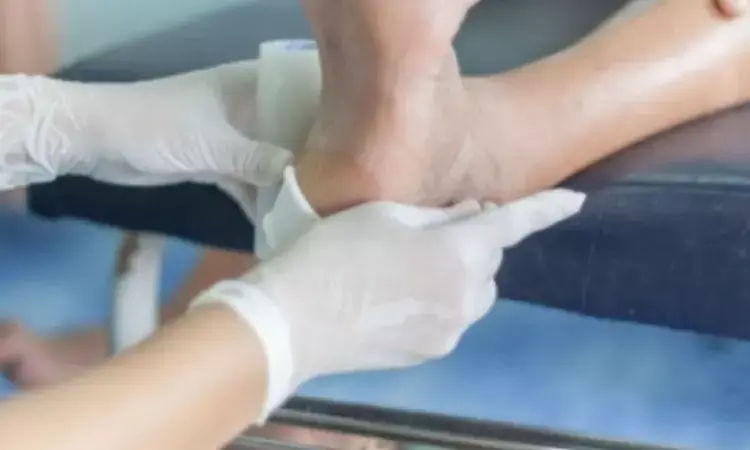- Home
- Medical news & Guidelines
- Anesthesiology
- Cardiology and CTVS
- Critical Care
- Dentistry
- Dermatology
- Diabetes and Endocrinology
- ENT
- Gastroenterology
- Medicine
- Nephrology
- Neurology
- Obstretics-Gynaecology
- Oncology
- Ophthalmology
- Orthopaedics
- Pediatrics-Neonatology
- Psychiatry
- Pulmonology
- Radiology
- Surgery
- Urology
- Laboratory Medicine
- Diet
- Nursing
- Paramedical
- Physiotherapy
- Health news
- Fact Check
- Bone Health Fact Check
- Brain Health Fact Check
- Cancer Related Fact Check
- Child Care Fact Check
- Dental and oral health fact check
- Diabetes and metabolic health fact check
- Diet and Nutrition Fact Check
- Eye and ENT Care Fact Check
- Fitness fact check
- Gut health fact check
- Heart health fact check
- Kidney health fact check
- Medical education fact check
- Men's health fact check
- Respiratory fact check
- Skin and hair care fact check
- Vaccine and Immunization fact check
- Women's health fact check
- AYUSH
- State News
- Andaman and Nicobar Islands
- Andhra Pradesh
- Arunachal Pradesh
- Assam
- Bihar
- Chandigarh
- Chattisgarh
- Dadra and Nagar Haveli
- Daman and Diu
- Delhi
- Goa
- Gujarat
- Haryana
- Himachal Pradesh
- Jammu & Kashmir
- Jharkhand
- Karnataka
- Kerala
- Ladakh
- Lakshadweep
- Madhya Pradesh
- Maharashtra
- Manipur
- Meghalaya
- Mizoram
- Nagaland
- Odisha
- Puducherry
- Punjab
- Rajasthan
- Sikkim
- Tamil Nadu
- Telangana
- Tripura
- Uttar Pradesh
- Uttrakhand
- West Bengal
- Medical Education
- Industry
Topical esmolol hydrochloride superior to standard of care for healing diabetic foot ulcers: Study

Delhi: A new study has found that the topical gel of esmolol hydrochloride 14% remarkably improves the healing of diabetic foot ulcers (DFU) versus the standard of care (SoC) and is safe. The findings were presented at the European Association for the Study of Diabetes (EASD) 2022 conference.
Esmolol hydrochloride, a β-1-selective (cardioselective) adrenergic receptor blocking agent, is administered intravenously that has been approved for treating supraventricular tachycardia and heart failure with fast ventricular rate. Previous research has shown the anti-inflammatory properties of esmolol, suggesting its potential role in the treatment of the diabetic foot. Considering this, A. Rastogi, Endocrinology, Post Graduate Institute of Medical Education and Research, Chandigarh, and colleagues proposed that a topical formulation may induce nitric oxide production, leading to fibroblast migration and mobilization of endothelial progenitor cells, thus speeding up wound healing in diabetes.
The researchers conducted a first double-blind, randomized, parallel-group, multicenter, phase-3 study performed at 27 centers across India to evaluate the effectiveness of topical esmolol hydrochloride gel for uninfected DFU. The study included patients with a non-infected total thickness (UTS 1B) DFU of duration>4 weeks, size 2cm2-15cm2, and ABI 0.7-1.3. They were randomized in the ratio of 3:3:1 after one week (run-in phase) to receive Esmolol + standard of Care (SoC), SoC only, or vehicle + SoC for 12 weeks (treatment phase) and followed until 24 weeks.
During the 12-week treatment phase for wound measurement and at weeks 14, 16, 20, and 24 during the follow-up phase, participants visited the investigational site once a week. Standard care included a moist wound environment, debridement, and off-loading with modified insole and shoes.
The study's primary outcome was the proportion of wound closure within 12-week in Esmolol + SoC and SoC only groups. The secondary outcomes were a proportion of participants achieving target ulcer closure (24 weeks) and time to ulcer closure during the treatment phase. Target ulcer closure was defined as 100% re-epithelialization, confirmed on two consecutive site visits two weeks apart. All analyses were conducted for intention-to-treat (ITT), i.e., safety evaluable population.
The screening of 251 participants was done, and 176 were randomized to the three groups.
The researchers found the following:
- The proportion of participants who achieved target ulcer closure within 12 weeks was 60·3% participants in Esmolol + SoC group compared to 41·7% participants in SoC only group (OR = 2·126).
- The proportion of target ulcer closure by the end of the study (week 24) was achieved in 44 of 77·2% participants in the Esmolol + SoC group and 55·6% participants in the SoC only group (OR = 2·708).
- The mean time for ulcer closure was similar (74·3 days for Esmolol + SoC group and 72·5 days for SoC only group).
- The Esmolol + SoC group showed a significant advantage over SoC in participants with BMI>25 kg/m2, high HbA1c, longer ulcer duration, hemoglobin<11 g/dl, low eGFR, and ulcers that did not achieve 50% area reduction within initial four weeks of treatment.
- The percent ulcer area reduction from end-of-treatment to end-of-study was 60·7% for Esmolol + SoC group compared to a negligible decrease of 2·7% in the SoC-only group.
To conclude, esmolol hydrochloride 14% topical gel treated diabetic foot ulcers much better than the standard of care (SoC) and did not cause significant drug-related safety issues.
Reference:
Rastogi A et al. Novel topical esmolol hydrochloride for diabetic foot ulcer: phase 3, randomised, double-blind, placebo-controlled, multi-centre study. Presented at the 58th European Association for the Study of Diabetes (EASD) Annual Meeting 2022 on 20 September 2022.
Dr Kamal Kant Kohli-MBBS, DTCD- a chest specialist with more than 30 years of practice and a flair for writing clinical articles, Dr Kamal Kant Kohli joined Medical Dialogues as a Chief Editor of Medical News. Besides writing articles, as an editor, he proofreads and verifies all the medical content published on Medical Dialogues including those coming from journals, studies,medical conferences,guidelines etc. Email: drkohli@medicaldialogues.in. Contact no. 011-43720751


